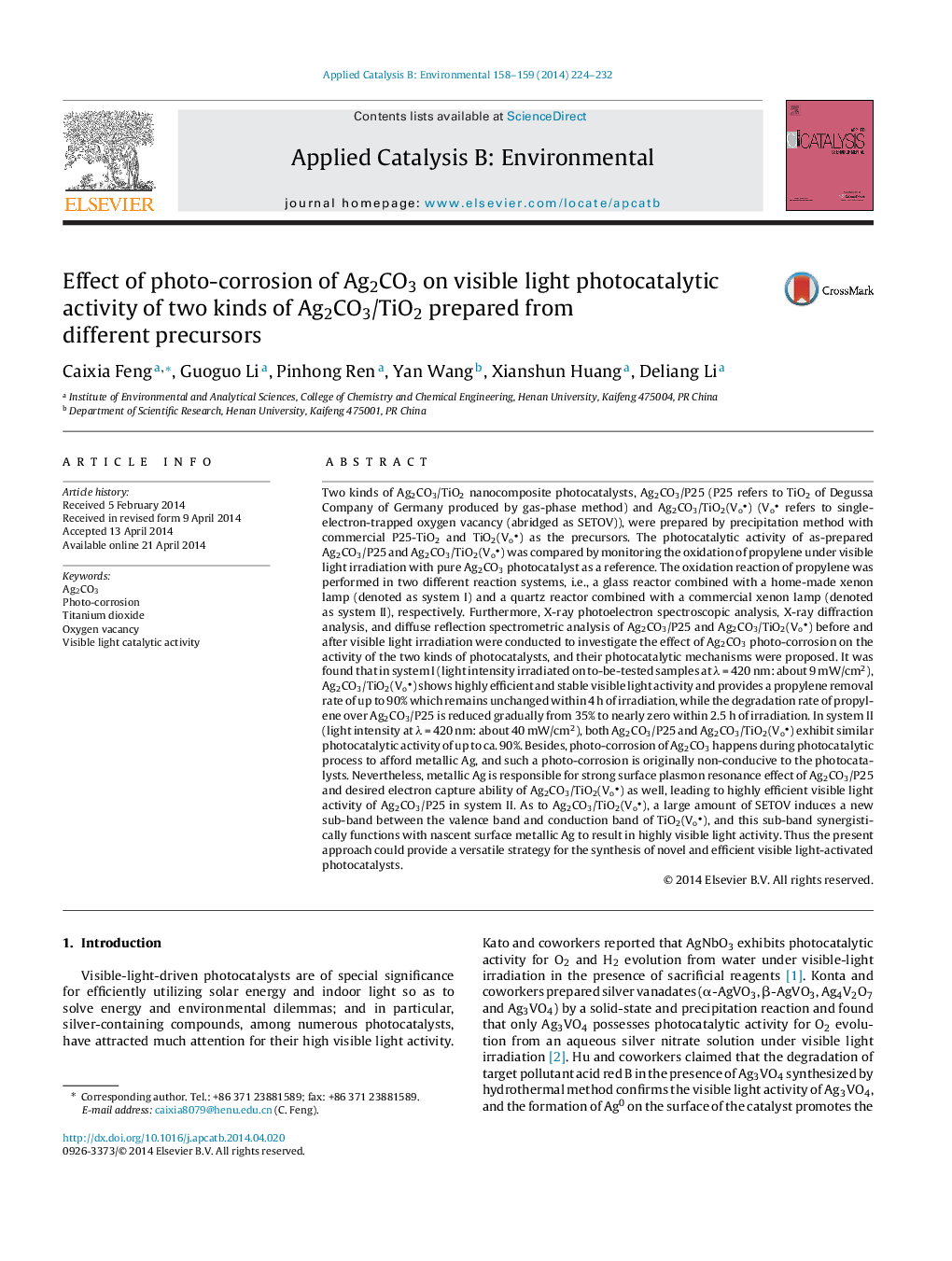| کد مقاله | کد نشریه | سال انتشار | مقاله انگلیسی | نسخه تمام متن |
|---|---|---|---|---|
| 45874 | 46426 | 2014 | 9 صفحه PDF | دانلود رایگان |

• Two kinds of Ag2CO3/TiO2 were separately prepared via a precipitation method.
• Ag2CO3/TiO2(Vo
• ) exhibits highly efficient stable visible light activity regardless of light intensity.
• The visible light activity of Ag2CO3/P25 differs markedly under different intensity irradiation.
• Photo-corrosion of Ag2CO3 on the surface of both Ag2CO3/TiO2 happens during photocatalytic process.
• Two different photocatalytic mechanisms of Ag2CO3/TiO2 were proposed.
Two kinds of Ag2CO3/TiO2 nanocomposite photocatalysts, Ag2CO3/P25 (P25 refers to TiO2 of Degussa Company of Germany produced by gas-phase method) and Ag2CO3/TiO2(Vo
• ) (Vo
• refers to single-electron-trapped oxygen vacancy (abridged as SETOV)), were prepared by precipitation method with commercial P25-TiO2 and TiO2(Vo
• ) as the precursors. The photocatalytic activity of as-prepared Ag2CO3/P25 and Ag2CO3/TiO2(Vo
• ) was compared by monitoring the oxidation of propylene under visible light irradiation with pure Ag2CO3 photocatalyst as a reference. The oxidation reaction of propylene was performed in two different reaction systems, i.e., a glass reactor combined with a home-made xenon lamp (denoted as system I) and a quartz reactor combined with a commercial xenon lamp (denoted as system II), respectively. Furthermore, X-ray photoelectron spectroscopic analysis, X-ray diffraction analysis, and diffuse reflection spectrometric analysis of Ag2CO3/P25 and Ag2CO3/TiO2(Vo
• ) before and after visible light irradiation were conducted to investigate the effect of Ag2CO3 photo-corrosion on the activity of the two kinds of photocatalysts, and their photocatalytic mechanisms were proposed. It was found that in system I (light intensity irradiated on to-be-tested samples at λ = 420 nm: about 9 mW/cm2), Ag2CO3/TiO2(Vo
• ) shows highly efficient and stable visible light activity and provides a propylene removal rate of up to 90% which remains unchanged within 4 h of irradiation, while the degradation rate of propylene over Ag2CO3/P25 is reduced gradually from 35% to nearly zero within 2.5 h of irradiation. In system II (light intensity at λ = 420 nm: about 40 mW/cm2), both Ag2CO3/P25 and Ag2CO3/TiO2(Vo
• ) exhibit similar photocatalytic activity of up to ca. 90%. Besides, photo-corrosion of Ag2CO3 happens during photocatalytic process to afford metallic Ag, and such a photo-corrosion is originally non-conducive to the photocatalysts. Nevertheless, metallic Ag is responsible for strong surface plasmon resonance effect of Ag2CO3/P25 and desired electron capture ability of Ag2CO3/TiO2(Vo
• ) as well, leading to highly efficient visible light activity of Ag2CO3/P25 in system II. As to Ag2CO3/TiO2(Vo
• ), a large amount of SETOV induces a new sub-band between the valence band and conduction band of TiO2(Vo
• ), and this sub-band synergistically functions with nascent surface metallic Ag to result in highly visible light activity. Thus the present approach could provide a versatile strategy for the synthesis of novel and efficient visible light-activated photocatalysts.
Figure optionsDownload as PowerPoint slide
Journal: Applied Catalysis B: Environmental - Volumes 158–159, October 2014, Pages 224–232